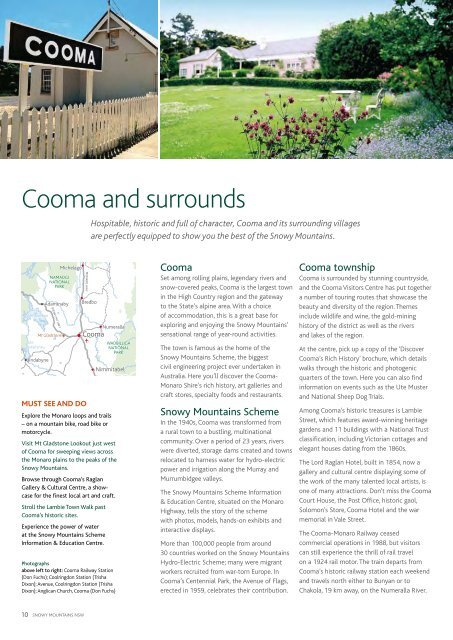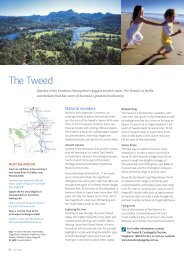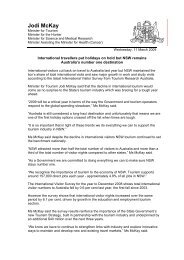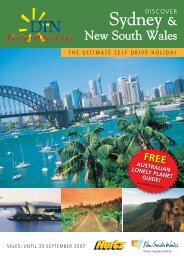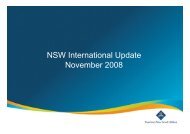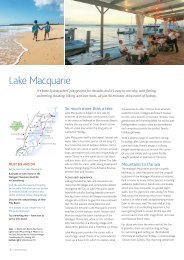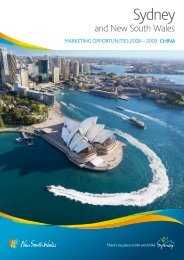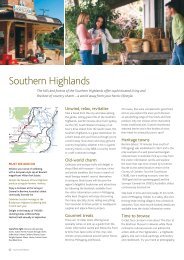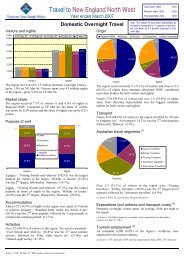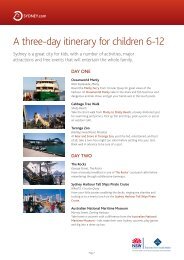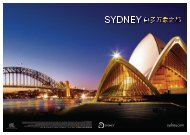Snowy Mountains NSW - Sydney's official guide to events ...
Snowy Mountains NSW - Sydney's official guide to events ...
Snowy Mountains NSW - Sydney's official guide to events ...
You also want an ePaper? Increase the reach of your titles
YUMPU automatically turns print PDFs into web optimized ePapers that Google loves.
Cooma and surrounds<br />
Hospitable, his<strong>to</strong>ric and full of character, Cooma and its surrounding villages<br />
are perfectly equipped <strong>to</strong> show you the best of the <strong>Snowy</strong> <strong>Mountains</strong>.<br />
<br />
<br />
<br />
<br />
<br />
<br />
<br />
<br />
<br />
<br />
<br />
<br />
Must see and do<br />
Explore the Monaro loops and trails<br />
– on a mountain bike, road bike or<br />
mo<strong>to</strong>rcycle.<br />
Visit Mt Glads<strong>to</strong>ne Lookout just west<br />
of Cooma for sweeping views across<br />
the Monaro plains <strong>to</strong> the peaks of the<br />
<strong>Snowy</strong> <strong>Mountains</strong>.<br />
Browse through Cooma’s Raglan<br />
Gallery & Cultural Centre, a showcase<br />
for the finest local art and craft.<br />
Stroll the Lambie Town Walk past<br />
Cooma’s his<strong>to</strong>ric sites.<br />
Experience the power of water<br />
at the <strong>Snowy</strong> <strong>Mountains</strong> Scheme<br />
Information & Education Centre.<br />
Pho<strong>to</strong>graphs<br />
above left <strong>to</strong> right: Cooma Railway Station<br />
(Don Fuchs); Coolringdon Station (Trisha<br />
Dixon); Avenue, Coolringdon Station (Trisha<br />
Dixon); Anglican Church, Cooma (Don Fuchs)<br />
<br />
<br />
<br />
<br />
<br />
<br />
<br />
<br />
Cooma<br />
Set among rolling plains, legendary rivers and<br />
snow-covered peaks, Cooma is the largest <strong>to</strong>wn<br />
in the High Country region and the gateway<br />
<strong>to</strong> the State’s alpine area. With a choice<br />
of accommodation, this is a great base for<br />
exploring and enjoying the <strong>Snowy</strong> <strong>Mountains</strong>’<br />
sensational range of year-round activities.<br />
The <strong>to</strong>wn is famous as the home of the<br />
<strong>Snowy</strong> <strong>Mountains</strong> Scheme, the biggest<br />
civil engineering project ever undertaken in<br />
Australia. Here you’ll discover the Cooma-<br />
Monaro Shire’s rich his<strong>to</strong>ry, art galleries and<br />
craft s<strong>to</strong>res, specialty foods and restaurants.<br />
<strong>Snowy</strong> <strong>Mountains</strong> Scheme<br />
In the 1940s, Cooma was transformed from<br />
a rural <strong>to</strong>wn <strong>to</strong> a bustling, multinational<br />
community. Over a period of 23 years, rivers<br />
were diverted, s<strong>to</strong>rage dams created and <strong>to</strong>wns<br />
relocated <strong>to</strong> harness water for hydro-electric<br />
power and irrigation along the Murray and<br />
Murrumbidgee valleys.<br />
The <strong>Snowy</strong> <strong>Mountains</strong> Scheme Information<br />
& Education Centre, situated on the Monaro<br />
Highway, tells the s<strong>to</strong>ry of the scheme<br />
with pho<strong>to</strong>s, models, hands-on exhibits and<br />
interactive displays.<br />
More than 100,000 people from around<br />
30 countries worked on the <strong>Snowy</strong> <strong>Mountains</strong><br />
Hydro-Electric Scheme; many were migrant<br />
workers recruited from war-<strong>to</strong>rn Europe. In<br />
Cooma’s Centennial Park, the Avenue of Flags,<br />
erected in 1959, celebrates their contribution.<br />
Cooma <strong>to</strong>wnship<br />
Cooma is surrounded by stunning countryside,<br />
and the Cooma Visi<strong>to</strong>rs Centre has put <strong>to</strong>gether<br />
a number of <strong>to</strong>uring routes that showcase the<br />
beauty and diversity of the region. Themes<br />
include wildlife and wine, the gold-mining<br />
his<strong>to</strong>ry of the district as well as the rivers<br />
and lakes of the region.<br />
At the centre, pick up a copy of the ‘Discover<br />
Cooma’s Rich His<strong>to</strong>ry’ brochure, which details<br />
walks through the his<strong>to</strong>ric and pho<strong>to</strong>genic<br />
quarters of the <strong>to</strong>wn. Here you can also find<br />
information on <strong>events</strong> such as the Ute Muster<br />
and National Sheep Dog Trials.<br />
Among Cooma’s his<strong>to</strong>ric treasures is Lambie<br />
Street, which features award-winning heritage<br />
gardens and 11 buildings with a National Trust<br />
classification, including Vic<strong>to</strong>rian cottages and<br />
elegant houses dating from the 1860s.<br />
The Lord Raglan Hotel, built in 1854, now a<br />
gallery and cultural centre displaying some of<br />
the work of the many talented local artists, is<br />
one of many attractions. Don’t miss the Cooma<br />
Court House, the Post Office, his<strong>to</strong>ric gaol,<br />
Solomon’s S<strong>to</strong>re, Cooma Hotel and the war<br />
memorial in Vale Street.<br />
The Cooma-Monaro Railway ceased<br />
commercial operations in 1988, but visi<strong>to</strong>rs<br />
can still experience the thrill of rail travel<br />
on a 1924 rail mo<strong>to</strong>r. The train departs from<br />
Cooma’s his<strong>to</strong>ric railway station each weekend<br />
and travels north either <strong>to</strong> Bunyan or <strong>to</strong><br />
Chakola, 19 km away, on the Numeralla River.<br />
10<br />
<strong>Snowy</strong> <strong>Mountains</strong> <strong>NSW</strong>


